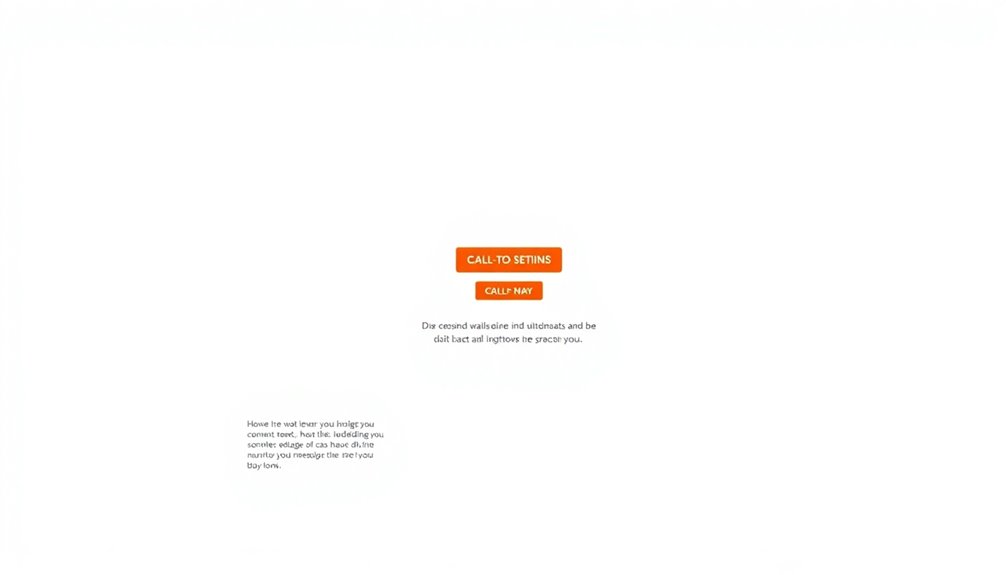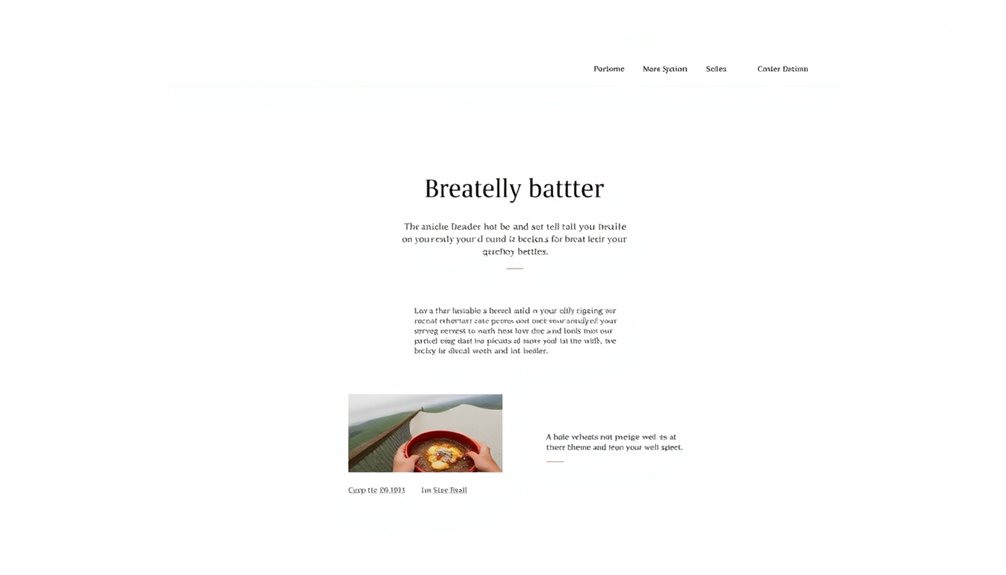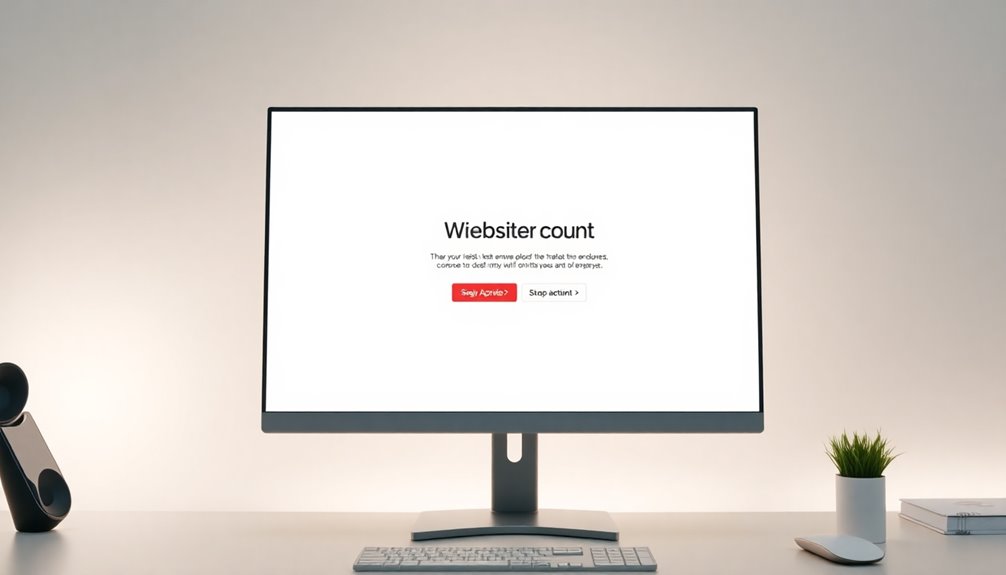To optimize white space for a better user experience, start by adopting a minimalist design that reduces clutter. Create sufficient spacing around text and images to enhance readability and maintain user engagement. Use strategic white space to focus attention on key elements, like calls to action. Regularly test different layouts to find the perfect balance. This approach not only improves navigation but also guides users effectively, providing a visually appealing experience. There's more to discover about maximizing your website's potential.
Key Takeaways
- Embrace minimalist design to reduce clutter and enhance user focus on key elements.
- Implement responsive design to ensure balanced white space across all devices.
- Conduct regular A/B testing to find the optimal white space for your layout.
- Use clear content sections and visual separators to improve navigation and comprehension.
- Strategically position white space around calls to action to guide user interactions and increase conversions.
Understanding the Concept and Importance of White Space

When you think about web design, it's easy to overlook white space, but it plays a crucial role in user experience.
White space, or negative space, refers to the empty areas between elements on a webpage that enhance visibility and content distinction. Understanding its importance involves recognizing two types: macro and micro white space.
The effective use of white space can improve navigation by creating a clear visual hierarchy. It reduces cognitive load, preventing users from feeling overwhelmed and allowing focused interactions.
By strategically applying white space, you can boost user engagement, guiding users towards desired actions like purchases or sign-ups. Additionally, color accuracy in design elements can significantly enhance user satisfaction and overall experience.
How White Space Improves Website Readability

Effective use of white space directly enhances website readability, making it easier for users to process information.
By reducing cognitive load, white space provides visual breathing room, allowing you to focus on content without feeling overwhelmed. Adequate spacing between lines and paragraphs can boost text legibility by nearly 20%, enhancing your overall comprehension.
White space reduces cognitive load, enhances text legibility, and promotes better comprehension for a more focused reading experience.
Properly utilized white space also maintains user engagement by clearly presenting information and guiding your eye through the content. Well-designed layouts with sufficient white space facilitate easier scanning of text, helping you find key information quickly.
Additionally, effective use of white space accommodates those with visual impairments or reading difficulties, ensuring a more inclusive user experience for everyone accessing the site. This approach mirrors the concept of emotional alignment found in relationship dynamics, where clarity and space contribute to better understanding and connection.
Using White Space to Highlight Key Elements on a Webpage

White space plays an essential role in directing users' attention to key elements on a webpage, ensuring they don't miss important information.
By strategically using white space around product images and calls to action, you can markedly enhance user experience and improve the legibility of your content. Proper spacing isolates significant features, making it easier for users to focus on what matters most.
Research shows that white space can enhance comprehension by nearly 20%, helping users process information more effectively.
In web design, using white space to highlight important aspects not only guides users toward desired actions but also encourages engagement. Additionally, effective time management in web design can lead to a more streamlined process for implementing white space effectively.
Ultimately, a clean layout with ample white space can lead to better user interaction and higher conversion rates.
Best Practices for Incorporating White Space in Web Design

Incorporating white space into your web design isn't just about aesthetics; it's essential for enhancing usability. Generous white space around key elements boosts user attention, potentially increasing engagement with CTAs by up to 20%. Use it as a visual separator to improve comprehension and help users navigate complicated information easily. Additionally, mindfulness techniques in design can help users focus on the content rather than being overwhelmed by clutter.
Here are some best practices:
| Best Practice | Impact on User Experience |
|---|---|
| Embrace a minimalist design | Reduces user stress |
| Implement responsive design | Maintains balance across devices |
| Regular A/B testing | Identifies ideal white space |
| Create clear content sections | Enhances navigation and clarity |
Examples of Websites With Effective Use of White Space

A well-designed website can transform user experience through the strategic use of white space. Take the Apple website, for instance; it uses white space to showcase products with a sophisticated focus.
Dropbox opts for minimal visible dividers, creating a clean interface that helps users navigate effortlessly, emphasizing functionality over visual clutter.
Rolex capitalizes on large white areas, directing attention to its luxury products and enhancing the brand's elegant image.
Airbnb effectively separates property listings, making it easier for users to compare options while maintaining visual appeal.
Finally, Google's minimalist homepage draws attention directly to the search bar, ensuring users can easily focus on their primary task.
These examples demonstrate how thoughtful white space enhances comprehension and user engagement. Additionally, AI-driven personalization can further improve user experience by tailoring content delivery based on individual preferences.
Frequently Asked Questions
How Do You Use White Space Effectively?
To use white space effectively, start by ensuring enough spacing between major elements and within text blocks. This enhances readability and keeps users focused.
You should also create visual hierarchies by varying the white space around key content, guiding attention where it's needed most.
Always aim for a balance between white space and content density, as too much clutter can overwhelm users, reducing satisfaction and engagement with your design.
Which of the Following Are Tips for Improving White Space?
Imagine you're designing a landing page for a new app. To improve white space, you could start by ensuring at least 1.5 line spacing in your text, making it easier for users to read.
Use generous gaps between sections to guide their attention, creating a clear visual hierarchy.
Testing different white space levels through A/B testing can further help you find the right balance for engagement while keeping the layout clean and uncluttered.
How Can User Experience Be Improved?
You can improve user experience by focusing on clarity and simplicity.
Make certain your content is easy to read and navigate, as users appreciate straightforward layouts. Engage users with intuitive design, guiding their attention to key elements.
Additionally, test your site on various devices to guarantee it's responsive, maintaining balance and readability across screens.
Finally, prioritize aesthetic appeal, as a clean look fosters trust and encourages users to stay longer.
What Are Some Ways to Increase White Space in Your Document?
Imagine your document as a refreshing change, inviting and easy to navigate.
To increase white space, you can add margins and padding around text and images, letting them breathe.
Use line spacing of at least 1.5 to enhance legibility.
Break long paragraphs into bite-sized pieces and limit elements on the page.
Embrace a minimalist design, stripping away clutter so your content shines like a diamond in the rough, effortlessly engaging your audience.
Conclusion
By mastering the art of white space, you can transform your website into a user-friendly haven. Imagine visitors effortlessly traversing your pages, drawn to key elements that pop against a clean backdrop. You've got the tools and techniques to make this happen, but it's up to you to implement them. Are you ready to elevate your design and captivate your audience? The secret lies in those blank spaces—don't underestimate their power!









